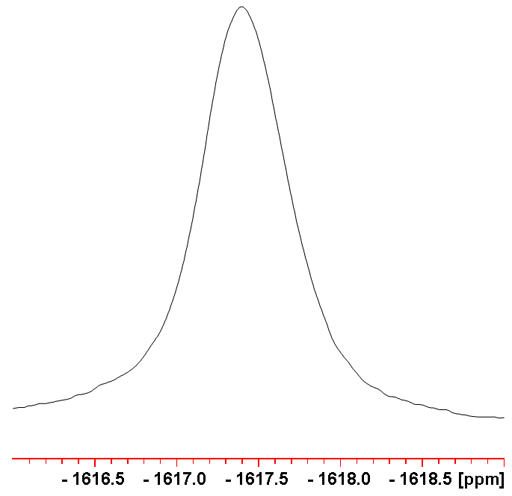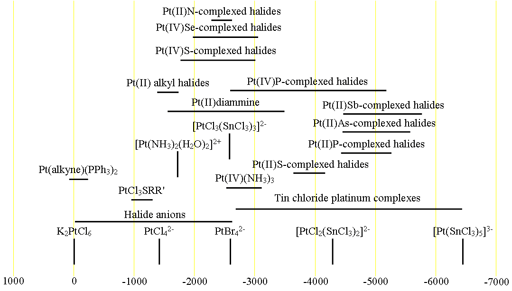(195Pt) Platinum NMR
Use our NMR service that provides 195Pt NMR and many other NMR techniques.
Platinum (Pt) has one medium sensitivity NMR spin-½ nucleus, 195Pt that yields narrow signals over a very wide chemical shift range (fig. 1). Because platinum has such a wide chemical shift range and 195Pt gives narrow signals, the slightest effect can be resolved as in the spectrum in fig. 2 where replacing 35Cl with 37Cl gives extra signals. 195Platinum NMR is mostly used for studying platinum complexes, their structure, conformation and dynamics, and platinum binding in biological systems. Because platinum is widely used as an industrial catalyst and in medicine, its chemistry and NMR has been widely studied.
Fig. 1. 195Pt-NMR spectrum of K2PtCl4 in D2O

Fig. 2. Resolution enhanced 195Pt-NMR spectrum of K2PtCl4 in D2O showing isotopomers

Each type of platinum its representative chemical shift range (fig. 3).
Fig. 3. Chemical shift ranges for platinum NMR

Platinum shows a wide variety of couplings with other nuclei, 1H, 13C, 15N, 31P, etc. Two-bond couplings to protons are between 25 and 90 Hz. One-bond 195Pt-15N couplings are in the region of 160 to 390 Hz. Couplings to 31P are around 1300 to 4000 Hz for one-bond and 30 Hz for two-bond. The one-bond coupling to 77Se is between 80 and 250 Hz. The platinum coupling to 119Sn is especially large and can be over 33000 Hz. Homonuclear platinum couplings can also be observed.
Properties of 195Pt
| Property | Value |
|---|---|
| Spin | 1/2 |
| Natural abundance | 33.832% |
| Chemical shift range | 6700 ppm, from -6500 to 200 |
| Frequency ratio (Ξ) | 21.496784% |
| Reference compound | 1.2 M Na2PtCl6 in D2O |
| Linewidth of reference | 5.3 Hz |
| T1 of reference | 0.4 s |
| Receptivity rel. to 1H at natural abundance | 3.51 × 10-3 |
| Receptivity rel. to 1H when enriched | 0.0104 |
| Receptivity rel. to 13C at natural abundance | 20.7 |
| Receptivity rel. to 13C when enriched | 61.2 |
Safety note
Some of the materials mentioned here are very dangerous. Ask a qualified chemist for advice before handling them. Qualified chemists should check the relevant safety literature before handling or giving advice about unfamiliar substances. NMR solvents are toxic and most are flammable. Specifically, platinum salts may cause allergies: wear protective gloves.
References
- E. M. Badley, B. J. L. Kilby, and R. L. Richards, "NMR spectra of carbene complexes of platinum (II)", J. Organometal. Chem., 27, C37-C38 (1971).
- S. M. Cohen and T. H. Brown, "Temperature dependence of platinum-195 nuclear resonance chemical shifts", J. Chem. Phys., 61, 2985-2986 (1974).
- L. P. Goggin, R. J. Goodfellow, S. R. Haddock, B. F. Taylor and I. R. H. Marshall, "The platinum-195 chemical shift in some platinum (0) and platinum (II) complexes and its relationship to their structure", J. Chem. Soc., Dalton Trans., 459-467 (1976).
- C. Brown, B. T. Heaton, P. Chini, A. Fumagalli and G. Longoni, "Stereochemical nonrigidity of a metal polyhedron; Fourier transform platinum-195 nuclear magnetic resonance spectra of [Ptn(CO)2n]2- (n = 3,6, or 9)", J. Chem. Soc., Chem. Comm., 309-311 (1977).
- S. S. Kurasova, S. N. Ivanova, L. Y. Al't, L. M. Gindin, A. A. Bezzubenko and V. A. Ershova, "Platinum-195 NMR study of the state of platinum in extracts with octylaniline", Seriya Khim. Nauk, 66-70 (1978).
- S. J. S. Kerrison and P. J. Sadler, "The convention for referencing platinum-195 NMR shifts and the cooperative shift effect for chloro-bromo complexes of platinum (IV) and -(II)", J. Magn. Reson., 31, 321-325 (1978).
- P. J. Sadler, "195-platinum NMR on the FX60" JEOL News, 15A, 16 (1979).
- J. Soulie, J. Y. Lallemand and R. C. Rao, "Platinum-195 NMR studies on monomer and dimer complexes. Observation of platinum - platinum coupling constants", Org. Magn. Reson., 12, 67-70 (1979).
- I. M. Al-Najjar, M. Green, S. Kerrison and P. J. Sadler, "Trans effects in platinum (II) complexes: platinum-195 nuclear magnetic resonance of nitrogen-15-labeled amine complexes", J. Chem. Res., Syn., 206-207 (1979).
- J. H. Nelson, V. Cooper and R. W. Rudolph, "The nature of platinum trichlorostannate salts in solution by multinuclear NMR. Unusually large spin-spin coupling, cluster size, fluxionality, and a caveat", Inorg. Nucl. Chem. Lett., 16, 263-265 (1980).
- G. K. Anderson, R. J. Cross and D. S. Rycroft, "Multinuclear magnetic resonance: sign of 1J(195Pt-13C), and platinum-195 chemical shifts in carbonyl complexes of platinum (II)", J. Chem. Res., Syn., 240-241 (1980).
- I. M. Ismail, S. J. S. Kerrison and P. J. Sadler, "Chlorine and bromine isotope shifts in platinum-195 NMR spectra", J. Chem. Soc., Chem. Comm., 1175-1176 (1980).
- S. J. S. Kerrison and P. J. Sadler, "Coordination of amides to cis-diamminediaquaplatinum dication", J. Chem. Soc., Chem. Comm., 61-62 (1981).
- Y. Koie, S. Shinoda and Y. Saito, "Platinum-195 nuclear magnetic resonance study of platinum (0) complexes containing a series of acetylenes", J. Chem. Soc., Dalton Trans., 1082 (1981).
- M. Hirayama and Y. Sasaki, "Observation of lanthanoid-induced platinum-195 shifts for the adduct of bis(acetylacetonato) platinum (II) with tris(8,8,8,7,7,6,6-heptafluoro-2,2-dimethyloctane-3,5-dionato)praseodymium(III) in trichloromethane-d solution", Chem. Lett., 195-196 (1982).
- S. K. Boocock, N. N. Greenwood, J. D. Kennedy, W. S. McDonald and J. Staves, "The chemistry of isomers of icosaborane(26), B20H26: synthesis and nuclear magnetic resonance study of various isomers of platinahenicosaboranes and diplatinadocosaboranes, and the x-ray crystal and molecular structures of 7,7-bis(dimethylphenylphosphine)-nido-7-platinaundecaborane and 4-(2'-nido-decaboranyl)-7,7-bis(dimethylphenylphosphine)-nido-7-platinaundecaborane", J. Chem. Soc., Dalton Trans., 2573-2584 (1981).
- K. H. A. Ostoja Starzewski, P. S. Pregosin and H. Ruegger, "Phosphorus-31, tin-119 and platinum-195 NMR studies of trichlorostannate complexes of Pt(II) and Pd(II). 2J 119Sn,117Sn)-values", Helv. Chim. Acta, 65, 785-797 (1982).
- L. Y. Alt, V. P. Mel'nikova, A. N. Startsev and V. K. Duplyakin, "Platinum-195 and tin-119 NMR studies of platinum-tin complexes in the platinum (II)-tin(II)-isopropyl alcohol system", React. Kinet. Catal. Lett., 23, 21-23 (1983).
- P. S. Pregosin and H. Ruegger, "Tin-119 and platinum-195 NMR spectroscopy of trichlorostannate(II) complexes of platinum and palladium. Some chemistry of the complexes (Ph4P)2[PtCl4] and [Pt(m-Cl)Cl(PEt3)]2 with tin(II) chloride", Inorg. Chim. Acta, 86, 55-60 (1984).
- T. G. Appleton, J. R. Hall and S. F. Ralph, "Nitrogen-15 and platinum-195 NMR spectra of platinum ammine complexes: trans- and cis-influence series based on platinum-195-nitrogen-15 coupling constants and nitrogen-15 chemical shifts", Inorg. Chem., 24, 4685-4693 (1985).
- D. D. Gummin, E. M. A. Ratilla and N. M. Kostic, "Variable-temperature platinum-195 NMR spectroscopy, a new technique for the study of stereodynamics. Sulfur inversion in a platinum (II) complex with methionine", Inorg. Chem., 25, 2429-2433 (1986).
- E. G. Hope, W. Levason and N. A. Powell, "Coordination chemistry of higher oxidation states. Part 21. Platinum-195 NMR studies of platinum (II) and platinum (IV) complexes of bi- and multi-dentate phosphorus, arsenic and sulfur ligands", Inorg. Chim. Acta, 115, 187-192 (1986).
- D. E. Berry, K. A. Beveridge, J. Browning, G. W. Bushnell and K. R. Dixon, "Ligand properties of phosphinito platinum complexes: phosphorus-31 and platinum-195 nuclear magnetic resonance studies and the crystal and molecular structure of [Cl(Et3P)Pt(m-PPh2O)2Pt(PEt3)2][BF4]", Can. J. Chem., 644, 1903-1911 (1986).
- H. J. Ruegg, P. S. Pregosin, A. Scrivanti, L. Toniolo and C. Botteghi, "Platinum (II) trichlorostannate chemistry. Importance of the platinum-tin linkage in hydroformylation chemistry and a novel PtC(OSnC12)R carbine", J. Organometal. Chem., 316, 233-241 (1986).
- P. Salvadori, G. Uccello-Barretta, S. Bertozzi, R. Settambolo and R. Lazzaroni, "Determination of the enantiomeric purity of chiral allyl alcohols and allyl ethers by platinum-195 NMR spectroscopy", J. Org. Chem., 53, 5768-5770 (1988).
- E. W. Abel, N. J. Long, K. G. Orrell, A. G. Osborne and V. Sik, "The syntheses, structures and stereodynamics of [3]ferrocenophane complexes. II. Trimethylplatinum(IV) halide complexes, [PtXMe3[(C5H4ECH3)2Fe]] (E = sulfur, selenium; X = chlorine, bromine, iodine)", J. Organometal. Chem., 378, 473-483 (1989).
- E. Baralt and C. M. Lukehart, "Phosphorus-31 and platinum-195 NMR data of several "T-frame" diplatinum complexes that exhibit unusual structure, bonding, and reactivity", Inorg. Chem., 29, 2870-2872 (1990).
- P. Salvadori, G. Uccello-Barretta, R. Lazzaroni and A. M. Caporusso, "A new method for the enantiomeric excess determination of chiral trisubstituted allenes by platinum-195 NMR of trans-dichloro[(S)-α-methylbenzylamine](allene) platinum (II) complexes", J. Chem. Soc., Chem. Comm., 1121-1123 (1990).
- T. Yamaguchi, K. Abe and T. Ito, "195Pt NMR of Tetranuclear Platinum (II) Cluster Complexes That Have Chemically Nonequivalent Nuclei: [Pt4(CH3COO)7(CH3CONH)] and [Pt4(CH3COO)3(CH3CONH)3]", Inorg. Chem., 33, 2689-2691 (1994).
- A. Yamasaki, M. Oike, T. Sugano, Y. Tanakura and T. Kinoshita, "Construction of hetero-atom NMR databases. II. platinum-195 NMR data. 1", Denki Tsushin Daigaku Kiyo, 7, 175-195 (1994).
- J. K. K. Sarhan, "195Pt-NMR studies on azaplatinacyclobutane complexes derived from allenes", Al-Azhar Bull. Sci., 6, 1417-1425 (1995).
- L. F. Krylova and A. V. Golovin, "NMR studies of transformations of Pt(II) and Pd(II) complexes with amino acids in solution. 1. Glycine complexes", J. Struct. Chem., 41, 243-253 (2000).
- A. Knodler, W. Kaim, V. K. Jain and S. Zalis, "Dimethylplatinum(II) and tetramethylplatinum(IV) complexes of 1-methyl-(2-alkylthiomethyl)-1H-benzimidazoles: experimental and DFT-calculated structures and NMR spectra", J. Organometal. Chem., 655, 218-226 (2002).
- M. Bouma, B. Nuijen, D. R. Stewart, K. F. Shannon, J. V. St. John, J. R. Rice, R. Harms, B. A. J. Jansen, S. van Zutphen, J. Reedijk, A. Bult and J. H. Beijnen, "Pharmaceutical quality control of the investigational polymer-conjugated platinum anticancer agent AP 5280", PDA J. Pharmaceut. Sci. Tech., 57, 198-207 (2003).
- F. D. Rochon and V. Buculei, "Study of Pt(II)-cyclic amines complexes of the types cis- and trans-Pt(amine)2I2 and cis- and trans-Pt(amine)2(NO3)2 and their aqueous products by", Inorg. Chim. Acta, 358, 2040-2056 (2005).
- A. Klein, T. Schurr, A. Knoedler, D. Gudat, K.-W. Klinkhammer, V. K. Jain, S. Zalis and W. Kaim, "Multiple Isomerism (cis/trans; syn/anti) in [(dmso)2Pt(aryl)2] Complexes: A Combined Structural, Spectroscopic, and Theoretical Investigation", Organometal., 24, 4125-4131 (2005).
- S. Lanza, G. Callipari, F. Loiseau, S. Serroni and G. Tresoldi, "195Pt NMR of Heteropolymetallic Complexes Containing Secondary Dithiooxamides as Binucleating Ligands", Inorg. Chem., 44, 6717-6724 (2005).
- J. R. L. Priqueler, I. S. Butler and F. D. Rochon, "An overview of 195Pt nuclear magnetic resonance spectroscopy", Appl. Spectrosc. Rev., 41, 185-226 (2006).